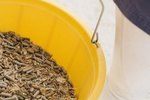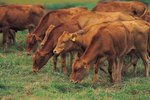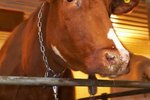
A hog's ration is made up of this concentrate, which is mostly cereal grains, with added ingredients to boost protein levels, calories and nutrients, added vitamins and minerals, and access to fresh, clean water. If any of these are missing, the hog will not grow to his full potential. For best growth, your hog also needs room to move around and vaccinations, as recommended by your veterinarian.
Types of Rations
There are two general types of rations used to feed hogs. Grower rations are fed to young, quick growing hogs who weigh less than 110 pounds. Grower rations have higher levels of protein as well as some minerals, such as calcium and phosphorus, that are important during growth. The second type of feed is a finishing ration. Once the hog reaches 110 pounds, he doesn't need the high level of nutrients required when he was younger. Feed changes can upset the hog's digestive system, so switch from the grower ration to the finishing ration gradually, starting with a half and half mix and gradually increasing the amount of finishing ration and decreasing the amount of grower ration during a period of a week or so.
Components of Feed
The main component of any hog ration is energy, or calories. The majority of the rations energy probably will come from one or more cereal grains, such as barley or corn. Oils and fats are concentrated forms of energy that are often added to the ration to boost the calorie count. Added protein sources also add calories to the ration. Because cereal grains are low in protein, particularly quality protein, such as amino acids, ingredients such as bone meal, soybean meal and milk byproducts are often added to the ration.
Vitamins and Minerals
Even a quality ration will often need added vitamins and minerals to ensure a fast growing hog gets the nutrients he needs. Trace minerals, such as copper and selenium, as well as vitamins such as A, D and K, are available as a pellet or powder to add to the feed, or as a loose granular to provide free choice. Sodium and chlorine are provided by free choice salt.
Feed and Weight Gain
The average young hog is capable of growing 1.5 to 1.8 pounds a day. It takes between 4 and 5 pounds of grain for every pound of weight gain in the hog. With that in mind, the average hog will consume between 4 and 8 pounds of ration each day. It is important to weigh the feed, so you know exactly how much you are feeding. Using a coffee can or scoop and feeding by volume, rather than weight, can lead to underfeeding or overfeeding your hog.
References
Photo Credits
-
Jupiterimages/Photos.com/Getty Images



